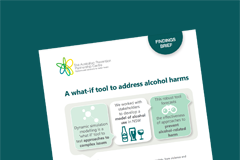A what-if tool to address alcohol harms
This Findings Brief PDF shows how a dynamic simulation model of alcohol use in NSW was used to forecast the
effectiveness of a variety of approaches and explore what combination of interventions is likely to achieve the best outcomes.
Key messages
- Excessive alcohol consumption causes a range of harms across society, from violence and
accidents to chronic health problems including heart disease, cancer and stroke. - Alcohol-related harm is a complex problem, with many inter-related causes. It can be difficult
for decision-makers to know which interventions, or combinations of interventions, is likely to
produce maximum community-wide impact. - Dynamic simulation modelling is a useful ‘what if’ tool that enables policy makers to test the
likely impact of a range of possible policy solutions before implementing them in the real world.
It has been widely used in other sectors. - This project developed a dynamic simulation model of alcohol use in NSW to forecast the
effectiveness of a variety of approaches and explore what combination of interventions is likely
to achieve the best outcomes. - The project found that combining different interventions can have undesirable effects; some
combinations have synergistic effects; and some produce impacts that are not visible within
a policy cycle.
